
List of Chengjiang Biota species by phylum
Encyclopedia
Phylum Arthropoda
77 species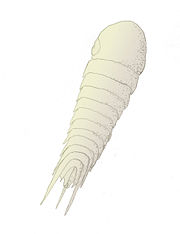


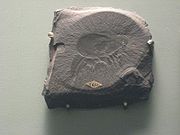

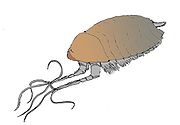

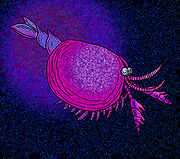

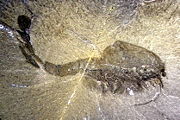
- Acanthomeridion serratumAcanthomeridionAcanthomeridion is an extinct arthropod found in the Chengjiang fauna deposits of China. In 1997, it was placed in its own, monotypic family, Acanthomeridiidae....
- AlalcomenaeusAlalcomenaeusAlalcomenaeus is one of the most widespread and longest surviving arthropod genera of the Early and Middle Cambrian. Known from over 300 specimens in the Burgess shale, and the Chengjiang, it bears great similarity to the opabiniids.-Morphology:...
- Almenia spinosa
- Apiocephalus elegans
- Branchiocaris yunnanensis
- Canadaspis laevigataCanadaspisCanadaspis was a Cambrian genus of crustacean or euarthropod, a benthic feeder that moved mainly by walking and possibly used its biramous appendages to stir mud in search of food...
- Chengjiangocaris longiformis
- Chuandianella ovata
- Cindarella eucalla
- Clypecaris pteroidea
- Combinivalvula chengjiangensis
- Comptaluta inflata
- Comptaluta leshanensis
- Cyathocepalus bispinosus
- Dianchia mirabilis
- Diplopyge
- D. forcipatus
- D. minutus
- Dongshanocaris foliiformis
- Ercaia minuscula
- Ercaicunia multinodosa
- Forfexicaris valida
- Forticeps foliosa
- Fuxianhuia protensaFuxianhuiaFuxianhuia protensa is a Lower Cambrian fossil arthropod known from the Chengjiang Fauna in China. Its purportedly primitive features have led to its playing a pivotal role in discussions about the euarthropod stem group...
- F. protensa
- Glossocaris occulatus
- G. occulatus
- Haikoucaris ercaiensis
- IsoxysIsoxysIsoxys was a bivalved arthropod, which was probably a free-swimming predator. It had a large pair of spherical eyes , and two large appendages, which have led to speculation that it may be related to the great appendage arthropods.- Ecology :It was abundant in tropical seas, and may have had a global...
- I. auritus
- I. curvirostratus
- I. paradoxus
- Jianfengia multisegmentalis
- Jianshania furcatus
- Jiucunella paulula
- Kuamaia
- K. lata
- K. muricata
- Kuanyangia pustulosaKuanyangiaKuanyangia is an extinct genus from a well-known class of fossil marine arthropods, the trilobites. It lived during the early part of the Botomian stage, which lasted from approximately 524 to 518.5 million years ago. This faunal stage was part of the Cambrian Period....
- Kunmingella
- Kuanyangia pustulosa
- K. angustacostata
- K. douvillei
- K. guanshanensis
- Kunmingocaris bispinosus
- Kunyangella cheni
- LeanchoiliaLeanchoiliaLeanchoilia is a four-eyed arachnomorph arthropod known from the Cambrian Burgess shale. It was about 5cm long and had long, whip-like feelers mounted on frontal arm-like appendages. Its guts are sometimes preserved in three dimensions....
- L. asiatica
- L. illecebrosa
- Liangshanella liangshenensisLiangshanellaLiangshanella is genus of Cambrian bradoriid known from the Chengjiang biota and Burgess Shale. -See also:* Cambrian explosion* List of Chengjiang Biota species by phylum...
- Liangshanella liangshenensis
- L. liangshenensis
- Mafangia subscalaria
- M. subscalaria
- Mafangocaris multinodus
- Malongella bituerculata
- Occacaris oviformisOccacarisOccacaris oviformis was a nektonic predatory arthropod from the Lower Cambrian Maotianshan shale Lagerstätte. It bears a superficial resemblance to the Cambrian arthropod, Canadaspis, though, was much smaller, and had a pair of "great appendages," with which it may have grasped prey with.It had a...
- Odaraia eurypetalaOdaraiaOdaraia is a genus of crustacean arthropod from the Middle Cambrian. Its fossils, which reach 15cm in length, have been found in the Burgess Shale in British Columbia, Canada....
- Ovalicephalis mirabilis
- Panlongia
- P. spinosa
- P. tetranudosa
- Parakunmingella malongensis
- Parapaleomerus sinensis
- Pectocaris spatiosa
- Petalilium latusPetaliliumPetalilium is an enigmatic genus of Cambrian organism of uncertain affinity known from the Haikou area, from the Maoshoiatan mudstone member of the Chengjiang biota.- Morphology :...
- Pisinnocaris subconigera
- Primicaris larvaformis
- Pseudoiulia cambriensis
- Pterotum triacanthus
- Pygmaclypeatus daiensis
- Rectifacies abnormalis
- Rhombicalvaria acanthi
- Saperion glumaceumSaperionFounded in 1985 in Berlin Germany, SAPERION AG has been developing software solutions for Enterprise Content Management systems, that brings archiving, document management and workflow functionality together in one system...
- Sidneyia sinicaSidneyiaSidneyia is an extinct arthropod known from fossils found in the Cambrian-age Burgess Shale formation of British Columbia. -General description:...
- Sinoburius lunaris
- Skioldia aldna
- Spinokunmingella typica
- Sunella grandis
- Squamacula clypeata
- Syrrhaptis intes
- Tanglangia caudata
- Trigoides aclisTrigoidesThe Trigoides genus is known from fossils from the Chengjiang Lagerstätte. It may be a type of ctenophore....
- Tsunydiscus aclis
- Tsunyiella daindongensis
- Tuzoia sinensisTuzoiaTuzoia is a large bivalved arthropod known from the Burgess Shale, British Columbia, and Kaili . This arthropod reached lengths of 180 mm long. There are currently 7 valid species recognized....
(a phyllocarid) - Urokodia aequalisUrokodiaUrokodia aequalis is an extinct genus of arthropod from the early Cambrian. The taxon is only known from the Maotianshan Shales of China, from which it was described by Hou et. al. based on some 15 specimens. It segmentation resembles that of a millipede and it possessed head and tail shields...
- Waptia ovataWaptiaWaptia fieldensis was a small, shrimp-like stem group crustacean. Many Cambrian crustaceomorphs such as Waptia lack the mouthparts to be classified as crown group crustaceans that lived during the Middle Cambrian about 510 million years ago...
- Wutingella binodosa
- Xandarella spectaculum
- Yiliangocaris ellipticus
- Yunnanocaris megista
ArachnomorphaArachnomorphaArachnomorpha Lameere 1890 is a subdivision or clade of Arthropoda, comprising the monophyletic group formed by the trilobites, other great appendage arthropods and trilobite-like families , and a diverse sister clade including the chelicerates...
2 species
- MisszhouiaMisszhouiaMisszhouia longicaudata is a species of blind, trilobite-like arthropod from the Cambrian period. In 1984 a well-preserved fossil of Misszhouia was discovered in the Maotianshan Shale; this discovery brought the shale to scientific attention.M...
- M. longicaudata
- NaraoiaNaraoiaNaraoia is a genus of trilobites found in Cambrian strata of the Burgess Shale and the Maotianshan shales Lagerstätte. They were flattened, oval-shaped animals, with an uncalcified shield that was divided into two regions, a smaller region covering the head, and a larger section covering the...
- Naraoia
- N. spinosa
Class TrilobitaTrilobiteTrilobites are a well-known fossil group of extinct marine arthropods that form the class Trilobita. The first appearance of trilobites in the fossil record defines the base of the Atdabanian stage of the Early Cambrian period , and they flourished throughout the lower Paleozoic era before...
5 species- Eoredlichia intermedia
- Kuanyangia pustulosa
- Palaeolenus lantenoisi
- Wutingaspis tingi
- Yunnanocephalus yunnanensis
Phylum BrachiopodBrachiopodBrachiopods are a phylum of marine animals that have hard "valves" on the upper and lower surfaces, unlike the left and right arrangement in bivalve molluscs. Brachiopod valves are hinged at the rear end, while the front can be opened for feeding or closed for protection...
a
5 species.- Diandongia pista
- Heliomedusa orienta
- Lingulella chengjiangensis
- Lingulellotreta malongensis
- Longtancunella chengjiangensis
Phylum ChordataChordateChordates are animals which are either vertebrates or one of several closely related invertebrates. They are united by having, for at least some period of their life cycle, a notochord, a hollow dorsal nerve cord, pharyngeal slits, an endostyle, and a post-anal tail...
8 species
- CathaymyrusCathaymyrusCathaymyrus is an Early Cambrian cephalochordate known from the Chengjiang locality in Yunnan Province, China. It had a long segmented body with no distinctive head. The segments resemble the v-shaped muscle blocks found in similar cephalochordates such as Amphioxus. A long linear impression runs...
- C. diadexus
- C. haikouensis
- HaikouellaHaikouellaHaikouella is a probable chordate from the Lower Cambrian Maotianshan shales of Chengjiang County in Yunnan Province, China.It is similar to the form Yunnanozoon, which is possibly a hemichordate. Still, there are anatomical differences from Yunnanozoon, including a larger stomach and smaller ...
- Haikouella
- H. jianshanensis
- H. lanceolata
- Haikouichthys ercaicunensis
- Myllokunmingia fengjiaoa
- Shancouclava anningense (a tunicateTunicateTunicates, also known as urochordates, are members of the subphylum Tunicata, previously known as Urochordata, a group of underwater saclike filter feeders with incurrent and excurrent siphons that is classified within the phylum Chordata. While most tunicates live on the ocean floor, others such...
) - Zhongxiniscus intermedius
Phylum CtenophoraCtenophoreThe Ctenophora are a phylum of animals that live in marine waters worldwide. Their most distinctive feature is the "combs", groups of cilia that they use for swimming, and they are the largest animals that swim by means of cilia – adults of various species range from a few millimeters to in size...
3 species- Maotianoascus octonarius
- Sinoascus paillatus
- Stromatoveris psygmoglena
Phylum EchinodermEchinodermEchinoderms are a phylum of marine animals. Echinoderms are found at every ocean depth, from the intertidal zone to the abyssal zone....
ata
3 species- Cotyledion tylodes
- Dianchicystis jianshanensis
- Vetulocystis catenata
Phylum HyolithaHyolithaHyolitha are enigmatic animals with small conical shells known from the Palaeozoic Era.-Shell morphology:The calcareous shells have a cover and two curved supports known as helens. Most are one to four centimeters in length and are triangular or elliptical in cross section...
8 species- Ambrolinevitus
- A. maximus
- A. platypluteus
- A. ventricosus
- Burithes yunnanensis
- Glossolithes magnus
- Linevitus
- L. billingsi
- L. flabellaris
- L. opimus
Phylum Lobopodia
6 species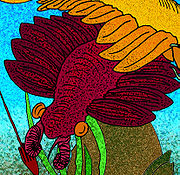
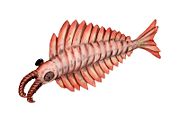
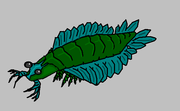
- Amplectobelua symbrachiataAmplectobeluaAmplectobelua is an extinct genus of anomalocaridid, a group of very early marine animals. While completely different from any animal alive today, some scientists do believe that the very primitive anomalocarids were in fact somewhat related to arthropods...
- AnomalocarisAnomalocarisAnomalocaris is an extinct genus of anomalocaridid, which are, in turn, thought to be closely related to the arthropods. The first fossils of Anomalocaris were discovered in the Ogygopsis Shale by Joseph Frederick Whiteaves, with more examples found by Charles Doolittle Walcott in the famed...
- A. saron
- A. symbrachiata
- Cardiodictyon catenulum
- Cucumericrus decoratusCucumericrusCucumericrus is a genus of anomalocaridid known from a few poorly-preserved specimens. Its great appendages are never preserved, but it does seem to bear walking legs, which have been interpreted as somewhere between lobopod legs and segmented arthropod legs....
- Hallucigenia fortisHallucigeniaHallucigenia is an extinct genus of animal found as fossils in the Middle Cambrian-aged Burgess Shale formation of British Columbia, Canada, represented by the species H. sparsa, and in the Lower Cambrian Maotianshan shale of China, represented by the species H. fortis...
- Luolishania longicruris
- Microdictyon sinicumMicrodictyonMicrodictyon is an extinct "armored worm" coated with dot-likescleritic scales, known from the Early CambrianMaotianshan shale of Yunnan China. Microdictyon is sometimes included...
- Onychodictyon ferox
- Parapeytoia yunnanensisParapeytoiaParapeytoia was a prehistoric animal that lived over 530 million years ago that lived in Maotianshan shales of prehistoric China. Like the anomalocarids that it resembled , Parapeytoia had two head appendages in front of the also anomalocarid like round mouth, eyes on stalks, and fleshy lobed...
- Paucipodia inermisPaucipodiaPaucipodia inermis is a lobopod known from the Lower Cambrian Chengjiang lagerstätte. Its gut is puzzling; in some places, it is preserved in three dimensions, infilled with sediment; whereas in others it may be flat...
Phylum NematomorphaNematomorphaNematomorpha is a phylum of parasitic animals that are superficially morphologically similar to nematode worms, hence the name. They range in size in most species from long and can reach in extreme cases up to 2 metres, and in diameter...
3 species- Cricocosmia jinningensis
- Maotianshania cylindrica
- Palaeoscolex sinensis
Phylum PoriferaSea spongeSponges are animals of the phylum Porifera . Their bodies consist of jelly-like mesohyl sandwiched between two thin layers of cells. While all animals have unspecialized cells that can transform into specialized cells, sponges are unique in having some specialized cells, but can also have...
15 species- Allantospongia mica
- Choia xiaolantianensis
- Choiaella radiata
- HazeliaHazeliaHazelia is a genus of spicular Cambrian demosponge known from the Burgess Shale, the Marjum formation of Utah, and possibly Chengjiang. It was described by Charles Walcott in 1920....
- Leptomitella
- Leptomitella confusa
- Leptomitella conica
- Leptomitella metta
- Leptomitus teretiusculus
- Paraleptomitella
- Paraleptomitella dictyodroma
- Paraleptomitella globula
- Quadrolaminiella
- Quadrolaminiella crassa
- Quadrolaminiella diagonalis
- Saetaspongia densa
- Sinfoflabrum antiquum
- Triticispongia diagonata
Phylum PriapulidaPriapulidaPriapulida is a phylum of marine worms. They are named for their extensible spiny proboscis, which, in some species, may have a shape like that of a human penis...
16 species
- Acosmia maotiania
- Archotuba conoidalis
- Corynetis brevis
- Gantoucunia aspera
- Lagenula triolata
- Oligonodus specialis
- Paraselkirkia jinningensis
- Palaeopriapulites parvus
- Protopriapulites haikouensis
- Sandaokania latinodosa
- SelkirkiaSelkirkiaSelkirkia is a genus of predatory priapulid worm known from the Middle Cambrian Burgess Shale. In the Burgess Shale, 20% of the tapering, organic-walled tubes are preserved with the worm inside them, whereas the other 80% are empty...
elongata - Selkirkia sinica
- Sicyophorus rarus
- Xiaoheiqingella peculiaris
- Xishania longgiusula
- Yunnanopriapulus halteroformis
Phylum VetulicoliaVetulicoliaVetulicoliaThe phylum name, Vetulocolia, is derived from the type genus, Vetulicola, which is a compound Latin word composed of vetuli, or "old," and cola, or "inhabitant." is an extinct phylum encompassing several Cambrian organisms...
9 species
- Heteromorphus longicaudatus
- VetulicolaVetulicolaVetulicola is a genus of small, Early Cambrian animals from the Chengjiang biota of China.-Description:The type species, Vetulicola cuneata has a body composed of two distinct parts of approximately equal length. The front part is rectangular with a carapace-like structure of four rigid cuticular...
- Vetulicola cuneata
- Vetulicola gantoucunensis
- Vetulicola rectangulata
- Vetulicola monile
- Beidazoon venustum
- XidazoonXidazoonThe genus Xidazoon was erected by Shu, et al. based on fossils found in the Qiongzhusi Formation, Yu'anshan Member , Lower Cambrian, Haikou, , about 50 km west of Chengjiang, China. It currently consists of the single species Xidazoon stephanus.The fossils show that the body of the animal...
stephanus - DidazoonDidazoonThe genus Didazoon was erected by Shu, et al. based on fossils found in the Qiongzhusi Formation, Yu'anshan Member , Lower Cambrian, in the Dabanqiao area , about 60 km northwest of Chengjiang, China...
hoae - Pomatrum ventralis
- YuyuanozoonYuyuanozoonYuyuanozoon magnificissimi is the largest known vetulicolian, with the holotype measuring about 202 millimeters in length. In life, it would have been an egg-shaped animal with a long cylindrical tail...
magnificissimi - YunnanozoonYunnanozoonYunnanozoon lividum is a suspected a hemichordate or chordate from the Lower Cambrian, Chengjiang biota of Yunnan province, China....
lividum (disputed, see Enigmatic below)
Enigmatic
24 species- AllonniaAllonniaAllonnia is a genus of coeloscleritophoran known as complete scleritomes from the Middle Cambrian Burgess Shale. It is also a constituent of the small shelly fauna....
phrixothrix - AmiskwiaAmiskwiaAmiskwia is a large, soft-bodied invertebrate of unknown affinity known from fossils of the Middle Cambrian Lagerstätten both in the Burgess shale formation in British Columbia and the Maotianshan shales of Yunnan Province, China....
sinica - Anthrotum robustus
- Batofasciculus ramificans
- Cambrotentacus sanwuia
- Conicula straita
- DinomischusDinomischusDinomischus is a rare fossil animal from the Cambrian period. It reached 100 mm in height, was attached to the sea floor by a stalk, and looked loosely like a flower. The cup-shaped body at the top of the stalk probably fed by filtering the surrounding seawater, and may have created a current...
venustus - Discoides abnormalis
- EldoniaEldoniaEldonia is a soft-bodied animal of unknown affinity, best known from the Fossil Ridge outcrops of the Burgess Shale, particularly in the 'Great Eldonia layer' in the Walcott Quarry...
eumorpha - FacivermisFacivermisFacivermis is a Cambrian organism known from Burgess shale-type localities including the Chengjiang....
yunnanicus - Hippotrum spinatus
- Jiucunia petalina
- Maanshania crusticeps
- Macrocephalus elongates
- Parvulonoda dubia
- Phacatrum tubifer
- Phasangula striata
- Phlogites brevis
- Phlogites longus
- Priscapennamarina angusta
- Pristitoites bifarius
- Rhipitrus calvifer
- RotadiscusRotadiscusRotadiscus is a genus of discoidal animal known from the Cambrian Chengjiang biota and classified with the eldoniids.As with other eldoniids, it was originally thought to have been pelagic, but is now thought to be benthic....
grandis - WiwaxiaWiwaxiaWiwaxia is a genus of soft-bodied, scale-covered animals known from Burgess shale type Lagerstätte dating from the upper Lower Cambrian to Middle Cambrian. The organisms are mainly known from dispersed sclerites; articulated specimens, where found, range from to a little over 50.8 millimeters in...
taijiangensis - Yunnanozoon lividumYunnanozoonYunnanozoon lividum is a suspected a hemichordate or chordate from the Lower Cambrian, Chengjiang biota of Yunnan province, China....
(earliest known hemichordate)
Kingdom ProtistProtistProtists are a diverse group of eukaryotic microorganisms. Historically, protists were treated as the kingdom Protista, which includes mostly unicellular organisms that do not fit into the other kingdoms, but this group is contested in modern taxonomy...
a (algae)
- Fuxianospira gyrata
- Megaspirellus houi
- Sinocylindra yunnanensis
- YuknessiaYuknessiaYuknessia is a very putative green alga known from three Burgess shale specimens, and some from the Chengjiang and Wheeler shale. Long, unbranched fronds emerge from a central holdfast-like body covered in small conical plates...

